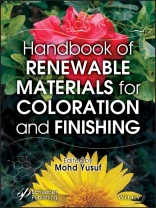The purpose of this unique handbook is to provide reference material that includes basic principles and current developments in the field of natural coloration and finishing.
A sustainable world requires the utilization of renewable materials or resources that can be produced in huge quantities for a wide range of applications. To adopt the use of active materials for textile coloration and finishing, they should reach the technical demands of the modern world such as eco-preservation, economic and ecological requirements by which, equity and sustainability might be considered. Therefore, there is a need to discuss and understand the challenges and solutions of textile coloration and functional finishing methodologies.
The 20 chapters comprising the Handbook of Renewable Materials for Coloration and Finishing are divided into four segments: Substrates for Coloration and Finishing; Renewable Colorants and their Applications; Advanced Materials and Technologies for Coloration; and Finishing and Sustainability.
Part I contains three chapters that overview the systematic discussion on the suitability, physical, chemical and processing aspects of substrates for coloration and finishing. Part II includes nine chapters and covers in-depth arguments on renewable colorants and their various applications including a chapter on bio-colorant’s application as photosensitizers for dye sensitized solar cells. Part III contains five chapters in which modern advancements and processing methods/technologies for coloration and functional finishing are presented comprehensively. Part IV contains two chapters that provide sustainable aspects of coloration and finishing.
O autorze
Mohd Yusuf received his Ph D from the Jamia Millia Islamia University, New Delhi, India in 2013. He is now an Assistant Professor at D/O Chemistry, YMD College, M. D. University, Nuh, Haryana, India. He has published more than 40 publications including research and review articles, as well as book chapters in edited volumes.












